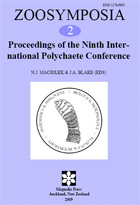Abstract
Nervous system and sensory structure morphologies provide useful information for reconstructing phylogenetic relationships among the Polychaeta, Annelida, and Arthropoda. With the more common use of indirect immunocytochemistry and laser scanning confocal microscopy methods, the detailed information available from morphological studies has increased. Despite this wealth of information, developing an integrated understanding of the ecology, physiology, morphology, and molecular mechanisms of sensory systems in polychaetes remains a challenge.
For many marine organisms, including polychaetes, chemical signals and chemoreception mediate numerous ecologically important behaviors including defense, reproduction, recruitment, and feeding, yet the mechanism of chemoreception in polychaetes has not been well described. This review summarizes research on the ecology and biology of polychaete chemoreception, particularly as it mediates reproduction, recruitment, and feeding, discusses the chemosensory structures of polychaetes, and describes recent advances in our understanding of chemoreception mechanisms in polychaetes.

